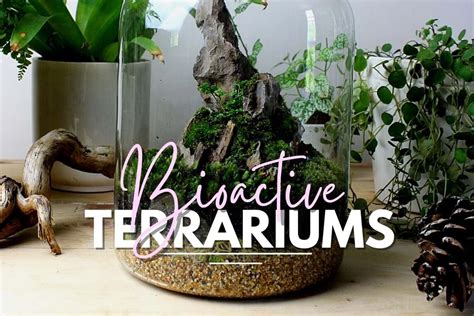Introduction
A bioactive terrarium represents a miniature ecosystem that mimics the natural habitats of reptiles, amphibians, and invertebrates. By incorporating live plants, a substrate teeming with microorganisms, and a carefully designed drainage system, bioactive terrariums offer a self-sustaining environment where organisms thrive and interact harmoniously. In this comprehensive guide, we will delve into the key elements of a successful bioactive terrarium setup, empowering you to create a thriving and captivating ecosystem.

Selecting the Right Enclosure
The size and shape of the terrarium will depend on the species you intend to house. Research the specific requirements of your target animal and select an enclosure that provides ample space for movement, climbing, and hiding. Vertical enclosures are particularly suitable for species that require climbing or burrowing.
Substrate Matters: Creating a Rich Ecosystem
The substrate forms the foundation of the bioactive terrarium. It provides a home for beneficial microorganisms, such as bacteria and fungi, which play a crucial role in breaking down organic matter and cycling nutrients. Select a substrate that is loose and well-draining, ensuring that it retains moisture while allowing excess water to drain away. Popular options include mixtures of coco fiber, sphagnum moss, and organic soil.
Drainage: Ensuring a Healthy Ecosystem
Proper drainage is essential for preventing waterlogging and maintaining the vitality of the ecosystem. Install a drainage layer at the bottom of the terrarium, consisting of materials such as hydroballs or gravel. The drainage layer should be sloped slightly to facilitate the flow of excess water.
Plants: The Green Lungs of the Terrarium
Live plants not only provide aesthetic appeal but also play a vital role in the bioactive terrarium. They absorb carbon dioxide and release oxygen, contributing to the overall air quality. In addition, plants provide hiding and basking spots for the terrarium’s inhabitants. Choose a variety of plants with different heights, textures, and growth patterns to create a diverse and visually appealing environment.
Lighting: Mimicking Natural Cycles
Appropriate lighting is crucial for maintaining circadian rhythms and regulating the activity patterns of animals. Provide a source of UVB light to allow for vitamin D synthesis, which is essential for calcium absorption and bone health. Choose a UVB bulb that is appropriate for the size of the terrarium and the species you are housing. Supplement UVB lighting with artificial sunlight to create a balanced lighting environment.
Establishing a Cleanup Crew: Beneficial Invertebrates
Invertebrates, such as springtails, isopods, and earthworms, serve as the “cleanup crew” of the bioactive terrarium. They consume organic matter, such as waste products and decaying plant material, and contribute to the decomposition process. Incorporating a variety of invertebrates ensures that the ecosystem remains balanced and efficient.
Monitoring and Maintenance
Regular monitoring is essential for ensuring the health of the bioactive terrarium. Observe the animals and plants for any signs of stress or disease. Monitor the temperature and humidity levels to ensure they are within the optimal range for the species housed. Perform regular cleaning, such as removing waste products and dead leaves, to maintain a hygienic environment.
Transitioning from a Standard Terrarium to a Bioactive Setup
Transitioning an existing standard terrarium to a bioactive setup requires gradual steps. Introduce live plants and a cleanup crew initially. Monitor the humidity levels and adjust accordingly. Slowly increase the amount of organic material in the substrate. Over time, the terrarium will transform into a thriving ecosystem.
Conclusion
Creating a bioactive terrarium is a rewarding experience that offers numerous benefits for the terrarium’s inhabitants and the environment. By incorporating live plants, a diverse substrate, and a cleanup crew, you can establish a self-sustaining ecosystem that mimics the natural habitats of your chosen species. With proper care and maintenance, a bioactive terrarium will not only provide a healthy and enriching environment for your animals but also create a captivating and educational experience for you and your family. Embrace the wonders of nature and embark on the journey of creating a bioactive terrarium that will thrive for years to come.
Additional Resources
- The Bioactive Terrarium: A Complete Guide to Setting Up and Maintaining a Naturalistic Ecosystem
- Bioactive Terrariums: A Comprehensive Guide to Creating Naturalistic Habitats for Reptiles, Amphibians, and Invertebrates
- The bioactive terrarium: definition, advantages, creation and care
Reviews
“The bioactive terrarium setup guide was incredibly comprehensive and provided me with all the information I needed to create a thriving ecosystem for my pet reptile.” – John, Reptile Enthusiast
“I was hesitant about transitioning my terrarium to a bioactive setup, but the guide made it so easy and seamless. My animals are so much happier now!” – Mary, Animal Lover
“The bioactive terrarium has been a game-changer for me. It’s so much easier to maintain and my animals are thriving. Highly recommend!” – Peter, Terrarium Enthusiast
“This guide is a must-read for anyone considering setting up a bioactive terrarium. It’s packed with valuable information and practical tips.” – Sarah, Nature Enthusiast
Frequently Asked Questions (FAQs)
Q: What are the benefits of a bioactive terrarium?
A: Bioactive terrariums provide a more natural and enriching environment for animals, reduce maintenance time, and create a self-sustaining ecosystem.
Q: What type of substrate is best for a bioactive terrarium?
A: A loose and well-draining substrate, such as a mixture of coco fiber, sphagnum moss, and organic soil, is recommended.
Q: How do I incorporate a cleanup crew into my bioactive terrarium?
A: Introduce invertebrates, such as springtails, isopods, and earthworms, to consume organic matter and contribute to the decomposition process.
Q: How often should I monitor my bioactive terrarium?
A: Regular monitoring is essential to ensure the health of the ecosystem. Observe animals and plants, check temperature and humidity levels, and perform cleaning as needed.
Q: Can I transition my standard terrarium to a bioactive setup?
A: Yes, but it requires gradual steps, such as introducing live plants and a cleanup crew and slowly increasing the amount of organic material in the substrate.





















